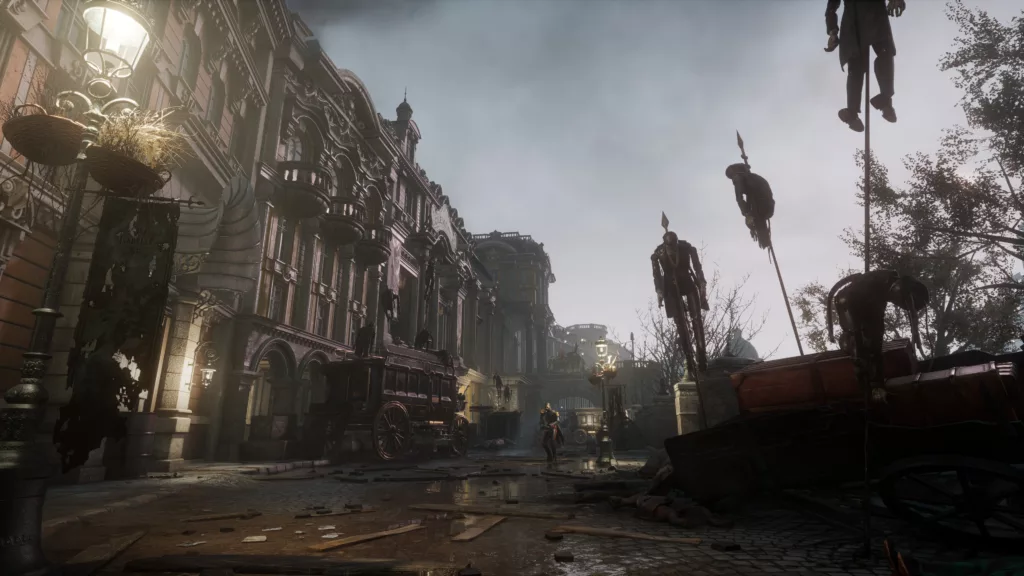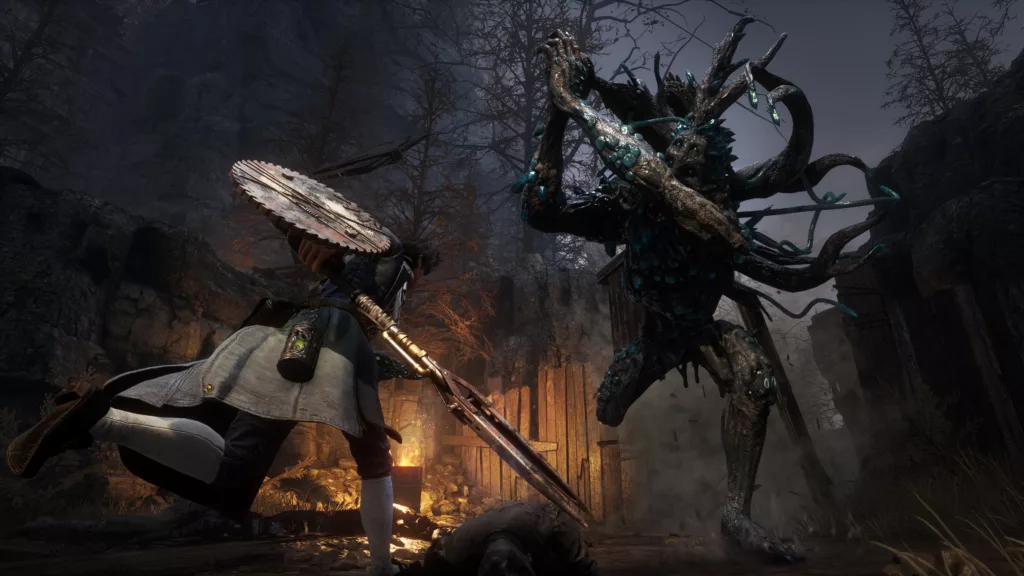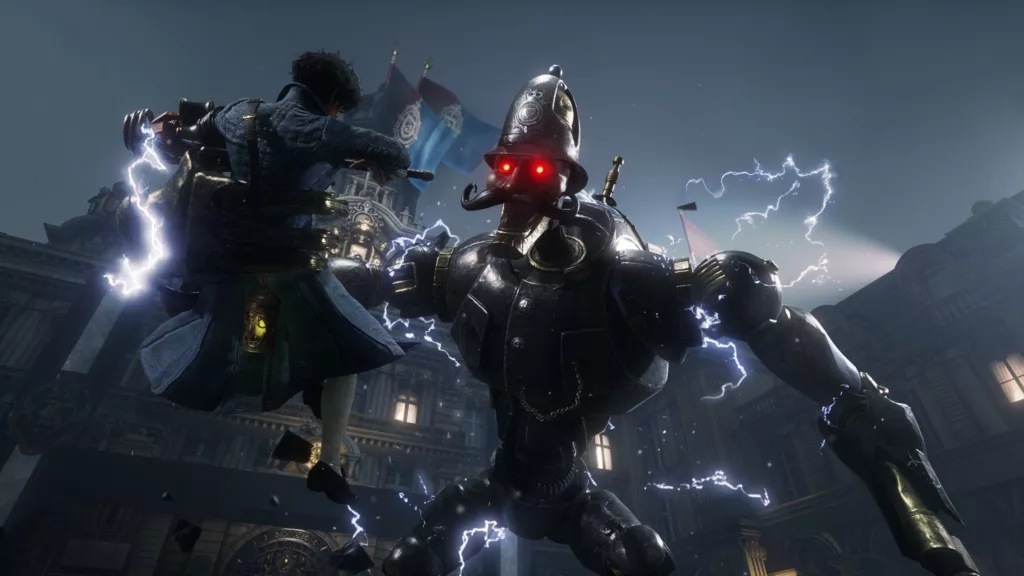As soon as I played the demo for Lies of P, I had a feeling we were going to get something special. The moody visuals and ambient sounds set the tone perfectly right from the start. The combat felt satisfying and bosses were the right side of challenging. I was all in.
Lies of P, from Neowiz and Round 8 Studios, is a typical action RPG that borrows ideas from various FromSoft games. This time, it does just enough to stand out from the crowd with its own take on various mechanics, but it will be mostly familiar.
As P, you will be expected to navigate the city of Krat, stop a murderous puppet uprising and explore some of the reasons behind why we lie. While initially rather rote, the story twists and turns as you meet potential allies. However, you are never quite sure who can be trusted.
Like the Souls games before it, it’s easy to miss what feels like the real meaning behind the story if you just mainline game. Careful exploration yields collectibles which flesh out the world and engaging with the various characters opens new questlines. Getting to know these people and their backstories added a great deal of depth.

It also introduces the lying mechanic. You see, folks round here don’t really like puppets what with all the murdering they are now capable of. Upon meeting many of the denizens, telling little white lies and telling them you are human, provides the opportunity to help them. This might be something simple like bringing a sick woman her baby or pretending to be a young boys friend. But the main cast have much deeper questlines that unfold as you find items and meet new people. It’s absolutely worth talking to them every time you see their faces appear on the fast travel screen. The puppet butler has a particularly touching story about love and his ruminations show a very human experience. What if I’m rejected? Maybe I shouldn’t say anything? The self awareness of feeling and the way he wrestles with doubt and self worth were intriguing.
It also left me contemplating why we lie. Pinocchio was told, that if he lied he’d never become a real boy, but we lie all the time. Sometimes the reasons are selfish and sometimes it’s for what we believe to be the benefit of others. They can’t all be bad right? It’s one of the things that makes us human and we need to deal with the consequences. This is what I felt the game truly was about – we lie because of how we feel or think others will feel. We are conscious of ourselves and the impact our words have in the world. So could a puppet technically become a human? Maybe I read too much into it, but it felt like there was a great deal of depth that was worth seeking out.
Gameplay follows the usual standard rules. You have a light and a heavy attack, you can guard or dodge and you’re heavily encouraged to learn how to parry. If you take a hit, you have an opportunity to get health back by getting in a few strikes of your own. This also happens when you guard but the damaged received is lower. Time the guard perfectly, and the enemy will be rocked, opening them up for counter. This also builds up a break bar that lets you perform a fatal attack, or if you’re really lucky, you’ll break their weapon.

Basic mobs are easy to read but the game does have a bad habit of throwing a damage sponge in the way and this only gets worse towards the end. A lot of these guys also have fury attacks that cannot be dodged or blocked and deal massive damage which can become a massive pain. One fight in particular had me shouting at the TV because the room was small, the enemy had a huge attack range and could shred my weapon durability with an acid attack that also decays your health. To make things more annoying, progression was literally gated until the big boy went down. I don’t mind getting blocked by a boss, but when a lot of these wandering mobs have a health pool and damage output akin to the first phase of most bosses, it gets tiring.
You’re going to die a lot, that’s to be expected. So it’s back to the last Stargazer and all XP, known as Ergo, is dropped. And here is where the next twist comes in. As usual, you need to run the gauntlet to get them back but every time you take damage, the amount in the pool drops. So do you run past everyone, or do you go for the greedy but risky option of killing everyone in your path again? Dying to a boss is less of a pain, in fact I really liked that it dropped your Ergo at the door before you enter.
Ah the bosses! Big damage sponges with some wild attacks that can overpower you in an instant. Deranged puppets give way to jacked up nightmare fuel and each of them are memorable in their own way. Unfortunately, not always for good reason. One particular boss who appeared about two thirds of the way into the game just felt overpowered. Despite the attacks being well telegraphed, their large reach and ability to add decay even through guard, as well as the things speed, put it at a difficulty on par with the Giant Ape from Sekiro. Wild movement, thrashing tentacles, combos that it could adjust on the fly to catch you with an unexpected extra attack. It was a pain and my grumbles were loud enough to get my Mrs to come and see what I was doing. Thankfully there are enough weapons and gadgets to deal with it all.

We’ve got small swords, big swords, things made out of tools. Special weapons, throwable objects and grindstones that allow you to repair your weapon on the go, as well as imbuing them with status effects. Lies of P also does away with the shield and and dual wielding instead replacing the left with a tool. This can be modified to fire a bullet, unleash a tether to get close to enemies, or maybe you fancy shocking things. Needless to say there’s lots of room for experimentation and different play styles. Not only that, but the blades and handles can be swapped about to create even more powerful variants.
I started with the faster short swords before falling in love with a Greatsword that was reminiscent of the Buster Sword from Final Fantasy, due to its reach and damage capabilities. In the end though, I settled on one of the unlockable boss weapons called Ouroboros. A long sword with a circular blade that could be revved up like a chainsaw to deal extra damage, or thrown like a discuss and spinning once it hits its target. Upgrading and fine tuning the weapons made them feel more personal. Being able to respec from around midway through the game also meant you could change your setup to get the best out of each bit of gear.
Upgrades can be gained for the P-Organ and this provides passive stat boosts. Defeating certain enemies drops quartz and these can be exchanged for permanent upgrades to healing flasks, stagger windows, and more. As for damage mitigation, armour works differently. Various parts of P’s body can be upgraded to improve resistances as well as base defence stats. Choosing weapons and parts becomes a balancing act as you try to keep underweight. Costumes are entirely cosmetic so choose whatever suits you at the time.
All these weapons would be uselss if the combat wasn’t up to snuff. I’m happy to say that everything is in order here. Attacks have weight and feel like they connect. Heavier hits can interrupt enemies and send them toppling and chaining them into combos is a joy. Movement feels grounded and P feels connected to the world which is welcome as other games can feel floaty. The parry and dodge windows are generous and while I favoured the agile approach, you will need to learn to parry if you hope to see the end. Eating a hit during a guard also means you can get a quick attack in during a break a regain health as well. Some encounters are easy to cheese with liberal use of throwables and baiting enemies to points where their aggro switches off. Some of them even get stuck on open doors, or struggle with slopes, so take advantage of that against those spongy roadblocks.

The overall presentation is another one of the highlights. Many have said it copies Bloodborne’s style too much, but I didn’t see that as a problem. The cobbled city streets are lined with beautiful Baroque architecture. All tall windows and towering town houses. A lavishly detailed train station is the opening area and one of the best looking. It feels familiar and welcoming, yet moody and foreboding with the steam swirling around the dim platform. The interior is filled with reflective marble floors and huge chandeliers hang from the vaulted ceilings. It’s quite a sight and reminded me of the entrance to Grand Central Station. The whole place is densely packed with stuff and gives each area a lived in feeling.
The lighting is also fantastic. With the HDR settings dialed in, the game really shines in the darker environments. Streetlamps flood the streets and torches flicker in pitch-black caves. Candles and lamps create small pockets of warmth in the shadowy houses you can explore. Paired with the highly detailed texture work, the whole thing sings.
Speaking of… voice work is good, but occasionally stumbles. Some of the delivery feels straight out of an English dub anime. Music is strangely absent apart from boss fights. Personally, I really liked being left with just the sound of my footsteps and the general ambient sounds of the city.

I fell in love with Lies of P from the moment I saw the trailers. These were always going to be lofty expectations for the game to meet, but I’m glad to say it all came together and the game is fantastic. With three endings and a multitude of hulking bosses to slay, its fair to say if you’re not a Souls fan, this probably won’t change your mind. But for the rest of us, Lies of P delivers a rich a detailed world full of things to find. The combat is on point, the environments are beautiful and the story is much deeper than it seems. I could quibble about animations locking in creating the odd sticky situation. The there’s the sneaky enemies hiding in areas where they can punt you off a cliff, but none of these things took the shine off my 40 hour play time. Lies of P is a more than worthy addition to the genre.
Overall
-
CX Score - 85%85%
Summary
Pros
- Presentation
- Combat
- Side stories
Cons
- Spongy wandering mobs
- Some dodgy voice work
- Overly long animations

